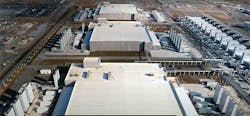Google Cloud Connects to SpaceX Starlink, Will Host Ground Stations at Data Centers
In the latest chapter of the cloud connecting to space, Google and SpaceX announced a partnership to connect SpaceX’s Starlink satellite broadband network to Google Cloud infrastructure, enabling the delivery of data, cloud services, and applications to enterprise customers at the network’s edge.
“Applications and services running in the cloud can be transformative for organizations, whether they’re operating in a highly networked or remote environment,” said Urs Hölzle, Senior Vice President, Infrastructure at Google Cloud. “We are delighted to partner with SpaceX to ensure that organizations with distributed footprints have seamless, secure, and fast access to the critical applications and services they need to keep their teams up and running.”
SpaceX will locate Starlink ground stations within Google data center properties, providing single-hop access between Starlink customers and Google Cloud infrastructure. While SpaceX Starlink beta customers have access to Google Cloud today through Starlink’s existing set of network connections, establishing direct connections between the SpaceX low earth orbit (LEO) satellite constellation and Google Cloud reduces latency and improves performance, especially when it comes to real-time communications such as voice and video.
“Combining Starlink’s high-speed, low-latency broadband with Google’s infrastructure and capabilities provides global organizations with the secure and fast connection that modern organizations expect,” said SpaceX President and Chief Operating Officer Gwynne Shotwell. “We are proud to work with Google to deliver this access to businesses, public sector organizations, and many other groups operating around the world.”
High-Speed Access at the Network’s Edge
For enterprise customers with large footprints, such as public sector agencies and those operating in rural areas, having access to low-latency high-speed broadband access is essential, especially where fiber or other alternatives aren’t available due to a lack of infrastructure. Starlink will provide these organizations with high-speed access at the network’s edge to complement and in some cases replace existing terrestrial connectivity.
“Combining Starlink’s high-speed, low-latency broadband with Google’s infrastructure and capabilities provides global organizations with the secure and fast connection that modern organizations expect.”
– SpaceX President and Chief Operating Officer Gwynne Shotwell.
Currently in beta, the SpaceX Starlink broadband network is providing users anywhere between 50 Mbps to 150 Mbps downlink speeds on average at a price of $499 for the user terminal/dish and $99 per month in service, with latencies between 20ms to 40ms. Some users are seeing speeds up to 300 Mbps with the latest network tweaks with that expected to be the norm this fall, according to a tweet from SpaceX CEO Elon Musk. While SpaceX has not committed to a formal timetable to move Starlink into commercial service, Musk has said he expects it to take place later this year.
An overhead view of data center buildings on a Google campus. These campuses have ample room to place satellite ground stations. (Image: Google)
The Google Cloud/Starlink capability for enterprise customers is expected to be available in the second half of 2021. Presumably, this means that multiple Google Cloud data centers will have Starlink ground stations installed and connected with the formal launch of services. The press release doesn’t make clear if Google Cloud enterprise customers will buy SpaceX Starlink services directly from Google as part of a larger package, or if separate arrangements will be made with Google forwarding enterprise customers over to SpaceX for the remote/edge connectivity piece.
Regardless of how customers get connected, SpaceX now has relationships with both Microsoft Azure and Google Cloud. Last fall, Microsoft announced it was working with satellite broadband provider SES to collocate SES ground stations with Microsoft data centers and have SpaceX Starlink as a connectivity option for the Microsoft Azure Modular Data Center.
Exactly how Microsoft Azure’s Starlink connectivity will square up against Google Cloud remains to be seen, since there’s been no public announcement of SpaceX putting ground stations directly next to Microsoft data centers.
Enterprise customers are going to end up comparing SES’s O3b mPower satellite network and its direct connection to Azure with SpaceX Starlink network connections to Azure at various interconnection points worldwide and the Google Cloud-Starlink ground station connections. Needless to say, it’s going to get complicated.







